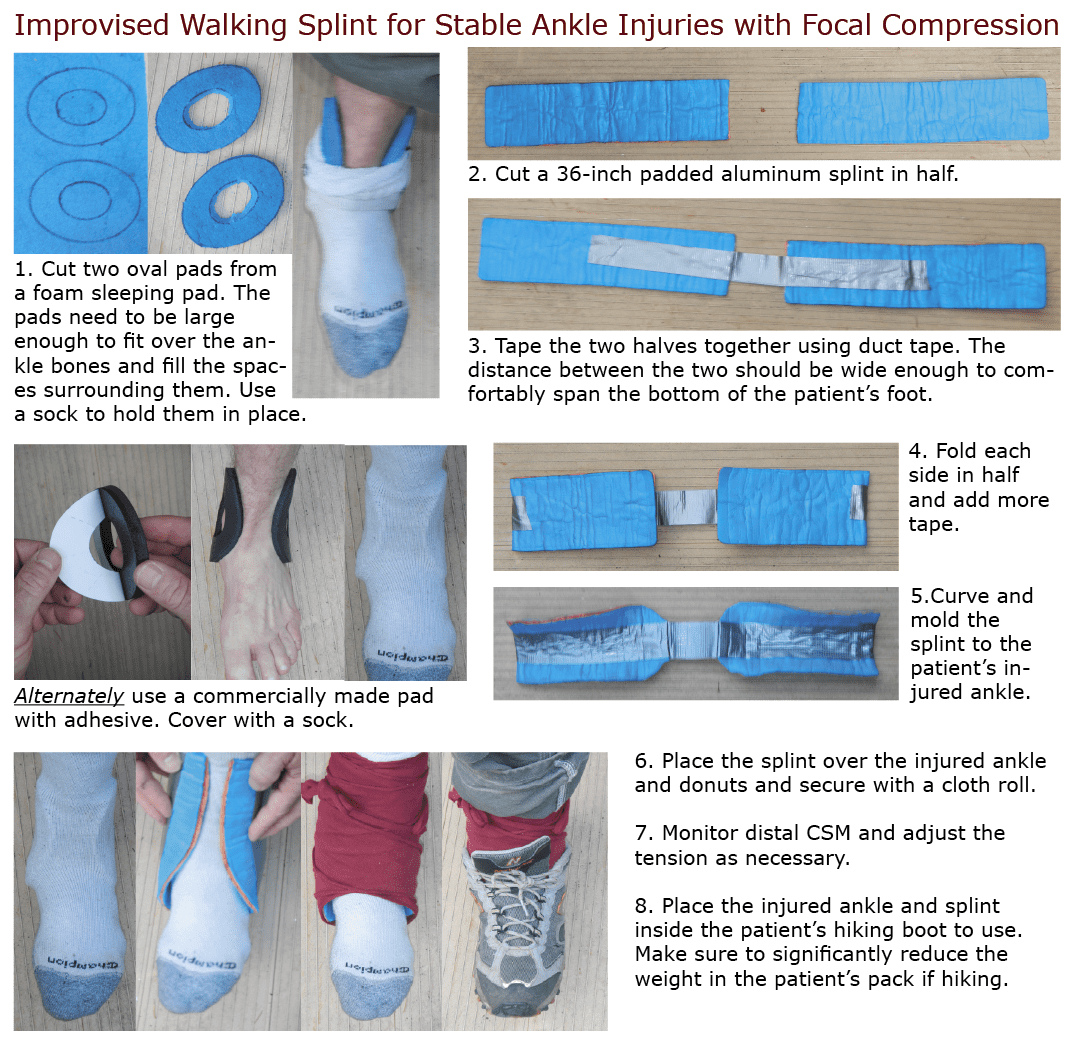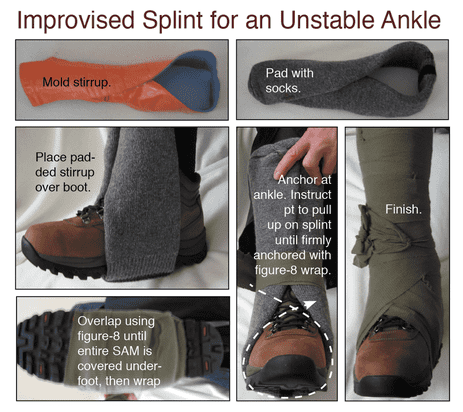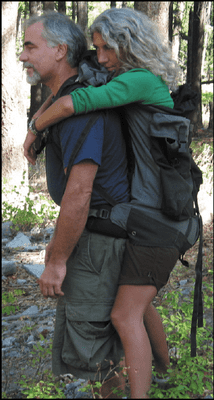|
Ankle injuries are, unfortunately, all to common on outdoor trips. Even though both stable and unstable ankle injuries cause soft tissue damage and swelling, field assessment is simple and based primarily on the patient's range of motion (ROM) and whether or not they are able to stand and bear weight shortly after the event. If their ROM is intact and they are able to bear weight, the injury is stable; if not, the injury is unstable. The vast majority of stable ankle injuries in the outdoors result from rolling the ankle laterally (to the outside) while hiking or running on an uneven surface. If the patient has no obvious deformity, tenderness slightly in front of and below the lateral malleolus (ankle bone on the ouside of the patient's leg), and can bear weight shortly after the event they probably have an uncomplicated lateral ankle sprain (sprain = ligament damage). If the ankle rolls inward (rare) the medial ligament complex may be damaged. Again, if the patient has no obvious deformity, presents with tenderness slightly below the medial malleolus (ankle bone on the inside of the patient's leg), and can bear weight shortly after the event, in all likelihood they have an uncomplicated medial ankle sprain. In uncomplicated ankle sprains, swelling can be prevented with compression around both malleoli (ankle bones), elevation of the injured ankle higher than the heart, cold water baths, and pain-free ROM and light strengthening exercises 2-3 times a day. Commercial compression donuts are super lightweight and come coated with a waterproof skin adhesive; simply peel off the backing and attach. Ideally, the patient should avoid extended walking on the injured ankle for 2-5 days. If the patient must walk during this time, you will need to support their ankle and significantly reduce their pack weight. Whether a patient requires an evacuation for an ankle sprain depends of the severity of the injury, the type of activity (backpacking, cycling, canoeing, etc.), and the difficulty of the terrain they can be expected to traverse. The first set of photos below show how to improvise a walking splint using a padded aluminum splint and foam donuts to deliver focal compression to the soft tissue surrounding the malleoli in order to prevent excessive swelling and promote rapid recovery in uncomplicated ankle medial or lateral ankle sprains. The second set show how to improvise a splint for an unstable ankle injury and adapt an expedition backpack to safely evacuate the patient. Carry patient's with unstable ankle injuries. On comfortalbe way is to cut the bottom side seams of your expedition pack and have the patient pull it on like a pair of pants; pad the groin area. Cut the seams carefully and they can be easily repaired later. If your carry-out is long, it is worth the extra time to get out your sewing kit and bar-tack the seams so they don’t tear further during use. While the patient may sit facing forward or backward, most patients and rescuers prefer to have the patient face forwards. A forward-facing position provides better balance for the rescuer and allows the rescuer to support the patient’s legs behind the knees when terrain permits, similar to a piggyback ride. (It’s nice to have a padded hipbelt and shoulder straps for a long evacuation.)
Want more information on this and other wilderness medicine topics? Take one of our wilderness medicine courses. Guides and expedition leaders should consider taking our Wilderness First Responder course. Looking for a reliable field reference? Consider consider purchasing one of our print or digital handbooks; our digital handbook apps are available in English, Spanish, and Japanese. Updates are free for life. A digital SOAP note app is also available.
1 Comment
9/18/2019 04:05:22 pm
I've noticed that when I went on a hiking trip last week, my left ankle was in a ditch and I got injured because I felt that I had a sprain. It's interesting to know that because my ankle had rolled inward, my medial ligament complex may have been damaged. I'll be sure to consult a professional service regarding this so I can get the best treatment option possible.
Reply
Your comment will be posted after it is approved.
Leave a Reply. |
Categories
All
Our public YouTube channel has educational and reference videos for many of the skills taught during our courses. Check it out!
|



 RSS Feed
RSS Feed
